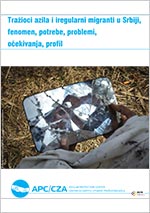 The aim of the research conducted by the Asylum Protection Center (APC / CZA) which was presented in the publication “The asylum seekers and irregular migrants in Serbia” is to highlight the new and rather unknown side of migration and asylum to the experts and the general public as a phenomenon that is increasingly present in our society and the region.
The aim of the research conducted by the Asylum Protection Center (APC / CZA) which was presented in the publication “The asylum seekers and irregular migrants in Serbia” is to highlight the new and rather unknown side of migration and asylum to the experts and the general public as a phenomenon that is increasingly present in our society and the region.
In just a few years, Serbia has faced two unknowns for the first time ever: establishment of the asylum system and the growing pressure of irregular migration within and through its territory. For the first time citizens have met with the strangers of other races, cultures and civilizations in the places where they live, or read in the media about the foreigners who reside in the local communities in the interior of Serbia. At the same time, the competent state authorities, government representatives and the courts have before them the matter of asylum which until recently was unknown and where they have challenges of additional training and gaining experience that represent strong aggravating factors in personal engagement and in the functioning of asylum system in Serbia in general. On the other hand, citizens of Serbia are not sufficiently familiar and often were misinformed about the asylum population. Consequently, among the citizens is being created resistance to asylum seekers, unfounded fear and misunderstanding.
Research conducted by APC / CZA between March 2012 to March 2013 year, has provided the answers to the questions about the road, ways of travel, needs, problems, expectations of asylum seekers and irregular migrants, reasons for abandoning the country of origin, experiences that they had during their stay and travel through Serbia. The study also provides recommendations how to correct the deficiencies of the asylum system in Serbia. Since the psychological profile of migrants and asylum seekers on the migration path is insufficiently researched material, so as the fact that the largest number of migrants and asylum seekers in Serbia ends up in one of the developed European countries at the end of this chain migration, the analysis will also be useful for foreign experts and general public of the European countries of destination of the migrants.
 AzilSrbija AzilSrbija
AzilSrbija AzilSrbija




